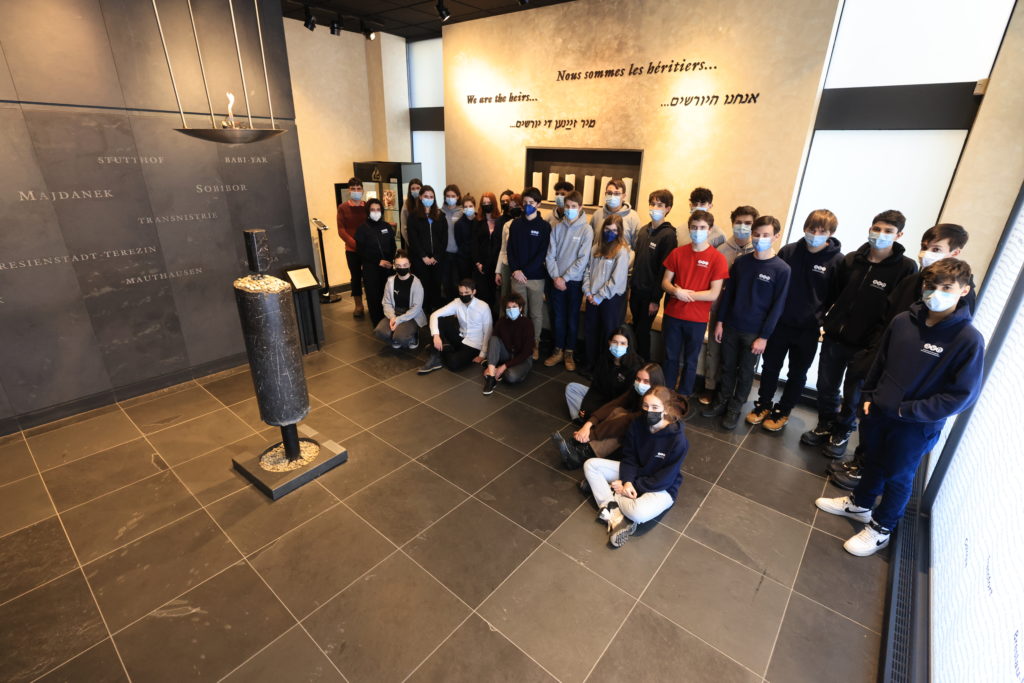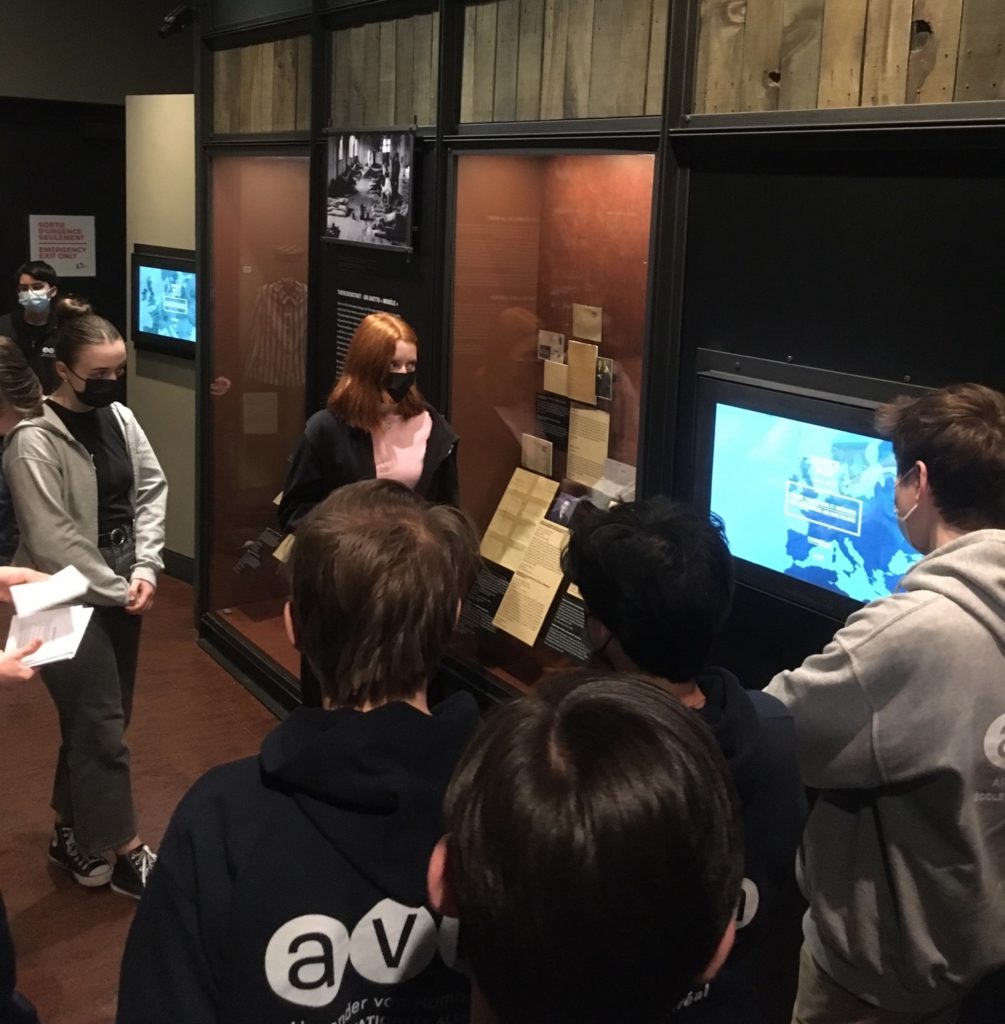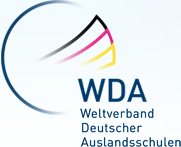
The History Department at AvH organized a visit to the Holocaust Museum in Montreal for students in grades 9, 10 and 12. The project was divided into two visits, one on February 17 and one on March 2. During the first visit, grade 12 students were given a personal guided tour of the museum, with each student acting as an expert on an exhibit which they had worked on thoroughly in advance. They practiced their short presentations and were offered helpful tips for improvement from the exhibition team. During the second visit on March 2, they presented this tour – with the support from the museum staff – to their peers in grades 9 and 10.
History teacher and Vice Principal of the school Tobias G. explains how the visit turned out to be a unique pedagogical cooperation with the museum, considering the role and responsibility of a German International School. He highlights how the experience significantly expanded the students’ knowledge of the Holocaust. According to Tobias, “such a cooperation is a valuable addition to our history curriculum, in which the Holocaust plays an important role. We as a German school are very conscious of our responsibility to remember the atrocities of the Nazi regime not only, but especially, against the Jewish community.”
Tobias highlights that students of grade 12 had the opportunity to take on the role of experts and active presenters, while the students of grade 9 and 10 could make connections to what they had learned in class through these presentations. Active learning is an academic approach engaging students with the course material through discussions, problem solving, case studies, role plays and other methods, while instructor guidance remains crucial *. It places a greater degree of responsibility on the learner than passive approaches.

Alexander von Humboldt is known for its approach to develop students skills and competencies allowing them to become active citizens in their communities, and to be able to adapt sound solutions to different problems. Students play an active role in the learning process by using acquired knowledge and new experiences to create new knowledge. We challenge students to apply their skills through collaboration, critical thinking, solving problems, and communication. Tobias adds that a museum visit offers that touch of authenticity combined with a close-up look at the time period through the objects that are displayed and explained. It brings the general facts and details down to an individual level: this doll belonged to a child named Marguerite, this prisoner’s uniform was worn by a real person by the name of Zigmund, etc. In this particular context, many members of the Jewish community who donated objects to the museum were and are still living in Montreal, which adds that local connection to the learning experience.
Marta K., a Grade 10 student, explains that in-class learning lets the students deal with PowerPoints, notes, and facts about rebellions, resistance, and wars. The added value from the museum project was that they saw real objects from that particular time period, and experienced them not through one text or particular point of view, but on their own, with feelings involved. According to Marta, “we saw the objects through our own eyes, we could feel them”. She adds that the experience felt so real, “I could touch the objects that lived with the people from that time. I didn’t see it as something far away, it was like a few steps from me”. Marta shares that one of the exhibits that evoked a strong sense of sadness was a big glass box containing two blue and white striped overalls the camp prisoners were forced to wear. She elaborates further, “when you actually see those overalls, and when you imagine the people who lived in these overalls and the horrible moments they had in the camps, in addition to what they had to go through, it feels very real. I stood there, and I cried”.
Vivid emotions elicited through a museum experience – this illustrates the AvH holistic educational approach which focuses on a student’s cognitive, emotional and social intelligence to grow not only academically, but also as a human being that is the product of culture and environment, by combining in-class teaching with real-world experiences.

Annabelle K., a Grade 12 student, experienced the project from a different position. She explains that students had to get to know one particular artifact up close, so the story of this one particular person really mattered, and they had to be ready to answer any question about their artifacts. According to Annabelle, “We had to be guides. We had to give tours to grade 9 and 10 students. We took them through what we learned one week earlier. You have to communicate with the other students, and this is a very interactive approach to learning and to sharing the knowledge with your peers”.
Annabelle explained that the museum focuses not on abstract information but on individual people, showing the faces behind the Holocaust and the atrocities of the Second World War instead of giving facts and figures learned in class. She had to see the connections from the facts she learned in class, and the stories she saw in the museum. According to Annabelle, the museum visit complemented and expanded the lessons learned in class. It is a good way of adding a personal dimension of history to the traditional learning mode. It gives a sense of how history is still in the making.
The museum also allowed some students to connect their own family history to the time period. Marta’s visit of the museum had a profound impact on her because her great-grandfather was a camp survivor. She still has some objects from him, such as letters that he sent to his parents where every other sentence is censored by the Nazis. The memory of him was spontaneously triggered by a small heart-shaped booklet on display at the museum . A camp prisoner by the name of Fania Fainer had received it as a twentieth-birthday gift from her fellow workers in the Union Werke, a munitions factory in Auschwitz. Nineteen of her fellow prisoners signed this booklet in their own languages, including Polish, Hebrew, German and French. One prisoner named Zlatka provided the purple fabric for the cover. She cut it from a blouse she had kept hidden, and was later beaten when guards discovered it.
Some of the women who risked their lives to give Fania this birthday present did not survive the war. To Fania, the heart was precious. She kept it with her on the death march which took her from Auschwitz to the concentration camp of Ravensbrück in January 1945. At the time of her liberation, it was her only personal belonging. Fania’s favourite message simply says “Freedom, freedom, freedom”. She immigrated to Toronto after the war and donated the booklet to the museum in 1988. In Marta’s view, this woman was leading her own passive resistance campaign by creating and keeping this book.

Marta ended her reflection on the museum trip with a connection to the current war raging in Ukraine. She is worried about a third World War, and wants to prevent history from “rhyming itself”, as per Mark Twain’s famous expression. In her own words, she calls for more active and vocal movements against violence and war. According to Marta, “this museum showed me the casualties, and what happened to the world. It showed me what happened to the people, and the terrible events people had to go through. That same thing will happen with Ukraine if we do not stop this war”.
References






